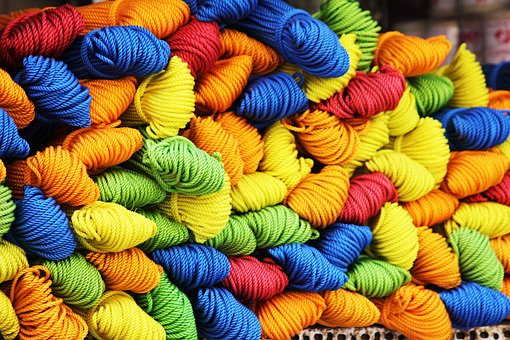 Anyone who knits, crochets, or weaves is aware of the standard wool, cotton, acrylic, or mixtures of yarns sold in places like Joannes, Michael's, or Hancock's craft stores. Out here, the corporation store carries acrylic yarn for knitting but the colors are quite limited.
Anyone who knits, crochets, or weaves is aware of the standard wool, cotton, acrylic, or mixtures of yarns sold in places like Joannes, Michael's, or Hancock's craft stores. Out here, the corporation store carries acrylic yarn for knitting but the colors are quite limited.If you manage to visit a real yarn shop, you might find yarns made out of unusual fibers which make crafts a bit more fun.
I love trying unusual fibers just because I have a curiosity on its feel, the texture, how well it knits up or even its feel on my skin. There are some fibers which are soft and nice while others might be used for rugs.
1. Camel hair yarn is made from the two humped Bactrian Camel found in colder climates such as Mongolia. The fur on their underbellies is the softest and collected every spring when the camels shed its winter coats. This fur is spun into a yarn that is warm, soft, and lightweight.
2. Muskox produces a layer of under wool closest to the body that is used to produce a yarn. The yarn does not shrink, is quite strong and warm. Its called Qiviut and is made up of fibers found rubbed against trees or plucked off the body during the spring when they shed. A male muskox can produce up to seven pounds of wool a year. It is also quite expensive.
3. Sugar cane yarn is made out of the fibers which remain after the sugar cane has been processed to remove the sugar. The fibers are then shredded, broken down, liquidized, and shot through small holes to create long strands that are colored and spun into yarn. Sugar cane yarn has a beautiful sheen and is quite silky. It is considered an eco friendly fiber.
4. Seaweed yarn is made when Icelandic seaweed is combined with cellulose fibers from eucalyptus trees to form a yarn called Seacel. It produces on of the most breathable fabrics on the market and is reputed to be good for the skin because it supposedly releases nutrients.
5. Milk Fiber was made back in the 1930's and 1940's to replace the wool used in the war effort. Milk fiber was made out of milk casein and the technique has been around since the early 1900's. It was used successfully for designer clothing.
6. Banana fiber yarn is made out of the plant once the bananas are harvested. Once made, it spins well, is lightweight, and is great at absorbing and releasing moisture.
On the scientific front, there are new and interesting fibers being created, some good, some not so good but its interesting where they are coming from. Scientists have discovered a type of bacteria that ferments cheap red wine into fibers. The clothing made out of this has a bit of an odor and it produces vinegar as a byproduct.
Fibers are being made out of wood pulp, spiders silk, corn, spoiled milk, recycled plastic bottles, used coffee pods, recycled newspaper, coconut husks, and cassette tape. I am not sure I'd want to knit any made with these items but you never know where the future will take us on this.
Let me know what you think. I'd be interested to hear.
No comments:
Post a Comment